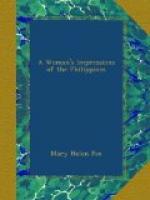Our guide from the Educational Department appeared about eleven o’clock the next day, which happened to be Sunday. We and our trunks were bundled into a launch, and we left the Buford forever.
We were familiar with the magazine illustrations of the Pasig long before our pedagogic invasion of Manila, but we were unprepared for the additional charm lent to these familiar views by the play of color. The shipping was as we had imagined it—large black and gray coasters in the Hong-Kong and inter-island trade, a host of dirty little vapors (steamers) of light tonnage, and the innumerable cascos and bancas. The bancas are dug-out canoes, each paddled by a single oarsman. The casco is a lumbering hull covered over in the centre with a mat of plaited bamboo, which makes a cave-like cabin and a living room for the owner’s family. Children are born, grow up, become engaged, marry, give birth to more children—in short, spend their lives on these boats with a dog, a goat, and ten or twelve lusty game-cocks for society.
The cascos lie along the bank of the river ten deep; every time a coasting steamer wants to get out, she runs afoul of them in some way, and there is a pretty mess. It always seems to turn out happily, but the excitement is great while it lasts, and it is apparently never dulled by repetition.
We swept up the Pasig with Fort Santiago and the ancient city wall on the right; and, on the left, warehouses, or bodegas, a customhouse with a gilded dome, and everywhere the faded creams and pinks of painted wooden buildings. Some of the roofs were of corrugated iron, but more were of old red Chinese tiles, with ferns and other waving green things sprouting in the cracks. The wall was completely hidden with vegetation.
We landed at the customhouse, left our trunks for inspection, and entered gig-like vehicles which were drawn by diminutive ponies and were called carromatas. Two of us were a tight fit, and, as I am stout, I was afraid to lean back lest I should drag the pony upon his hind legs, and our entrance into Manila should become an unseemly one. The carromata wheels were iron-tired, and jolted—well, like Manila street carromatas of that day. Since then a modification of the carromata and of another vehicle called calesin has been evolved. The modern conveyance has rubber tires and a better angle of adjustment, and the rat-like pony will dash about with it all day in good spirits.
We rattled up a street which I have since learned is called San Fernando, and which looks like the famous Chinatown of San Francisco, only more so. We passed over a canal spanned by a quaint stone bridge, arriving in front of the Binondo Church just as the noon hour struck. Instantly there burst out such a clamor of bells as we had never before heard—big bells and little bells, brass bells and broken bells—and brass bands lurking in unknown spots seemed to be assisting. I do not know whether the Filipinos were originally fond of noise or whether the Spaniards taught them to be so. At any rate, they both love it equally well now, and whenever the chance falls, the bells and the bands are ranged in opposition, yet bent to a common end.




